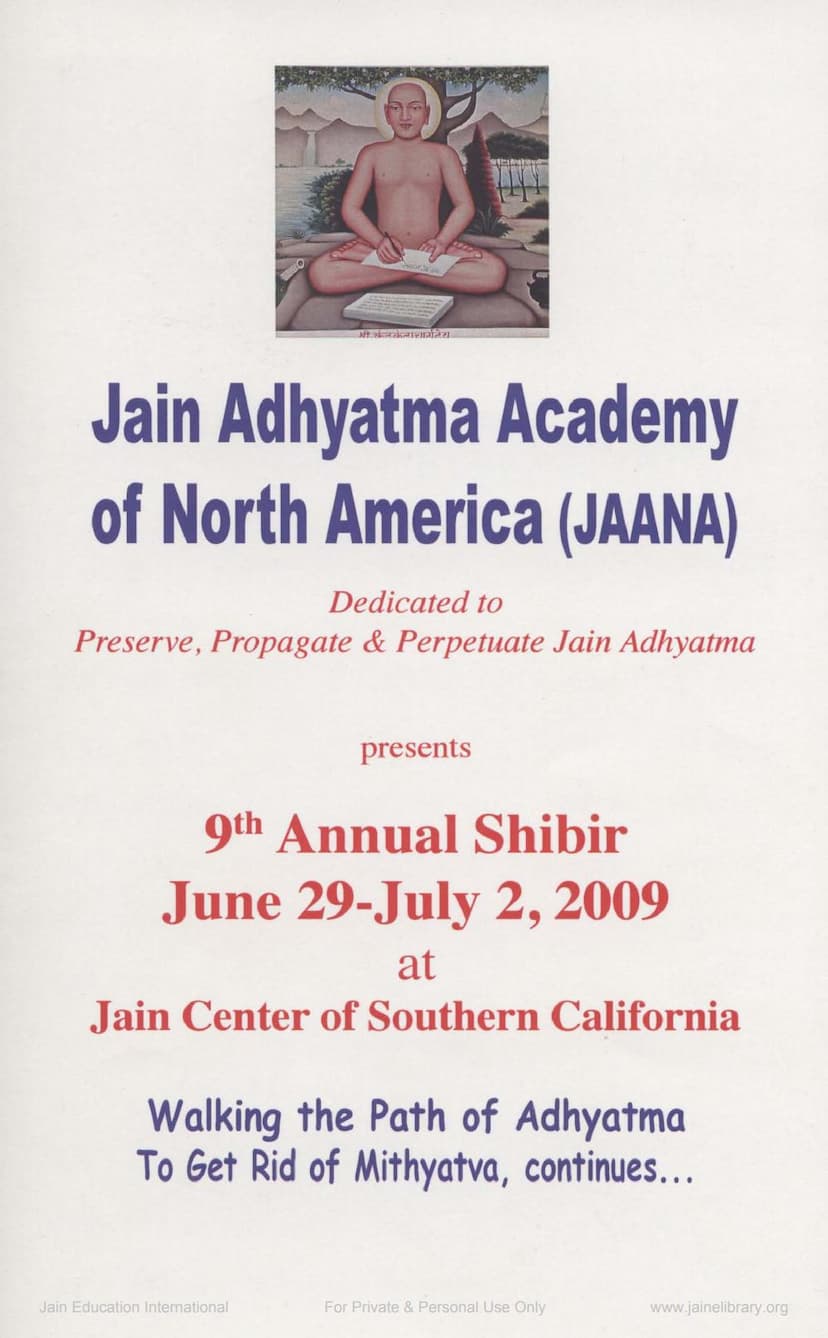Jain Adhyatma Academy Of North America
Added to library: September 1, 2025

Summary
Here's a comprehensive summary of the provided Jain text:
This document is a compilation of materials related to the 9th Annual Shibir (spiritual retreat) organized by the Jain Adhyatma Academy of North America (JAANA), held from June 29th to July 2nd, 2009, at the Jain Center of Southern California. JAANA's mission is dedicated to preserving, propagating, and perpetuating Jain Adhyatma (spiritual knowledge and practice). The theme of the Shibir was "Walking the Path of Adhyatma To Get Rid of Mithyatva (wrong belief/delusion)."
Key Components of the Document:
- Introduction (Page 1): Introduces JAANA and the 9th Annual Shibir.
- Shibir Agenda (Page 2): Provides a detailed daily schedule for the four-day retreat, outlining various activities like registration, dinner, puja (worship), breakfast, listening to Gurudev's CDs, lectures by Abhayji, Dr. Bharillji, and Dhirajbhai, tea breaks, social gatherings, and "Gyan Gosthi" (discussions on spiritual knowledge).
- Index (Page 3): Lists the various sections and the page numbers for:
- Stuti Section: Devotional hymns and prayers.
- Pooja Section: Rituals and worship procedures.
- Shastraji Section: Study of Jain scriptures and texts.
- Stavan Section: Devotional songs.
- Content Sections (Pages 4-66): The bulk of the document comprises Jain devotional literature, including:
- Darshan Stuti (Devotional Praise for Vision/Darshan): Several hymns expressing devotion to the Tirthankaras, highlighting the transformative power of their vision and the spiritual insights gained. These verses often contrast worldly pursuits with the peace found in devotion to the Jinas.
- Dev Darshan (Vision of the Divine): A hymn describing the joy and spiritual realization experienced through the Darshan of the Tirthankara idol, seeing one's own pure soul reflected in the divine form.
- Chaitya Vandana (Salutation to the Temple/Idol): A prayer to the Tirthankaras, acknowledging their victory over attachment and their ability to purify spiritual tendencies.
- 24 Tirthankar Stuti (Praise of the 24 Tirthankaras): A detailed praise of each of the 24 Tirthankaras, mentioning their names, key virtues, and their spiritual achievements.
- Vinay Path (Hymn of Humility and Gratitude): Expresses gratitude for a successful life due to the Tirthankara's darshan, leading to the overcoming of karma, delusion, and attachment, and a realization of one's true self.
- Aaradhana Path (Path of Devotion/Worship): A comprehensive prayer expressing desires for spiritual practices and attainments, such as devotion to the Arhats, Siddhas, Acharyas, Upadhyayas, and Sadhus; adherence to the Jain Dharma (non-violence); study of scriptures; practice of Samyak Darshan, Gyan, and Charitra; observance of vows; and devotion to the Tirthankaras and holy places.
- Pooja Pithika (Ritualistic Foundation): A preliminary prayer for commencing worship.
- Mangal Vidhaan (Auspicious Ritual): Hymns related to auspiciousness and purification, emphasizing the power of the Namokar Mantra.
- Svasti Mangal (Auspicious Well-being): Prayers for well-being, invoking the blessings of the Tirthankaras.
- Dev Shastra Guru Pooja (Worship of the Divine, Scriptures, and Spiritual Teachers): A detailed puja dedicated to the Tirthankaras (Dev), Jain scriptures (Shastra), and the spiritual lineage (Guru). It emphasizes the importance of these three jewels in guiding one towards the self.
- Specific Tirthankar Poojas: Detailed worship procedures for Shantinath, Mahavir, Siddh, Simandhar, Panchabalyati (five Tirthankaras who attained liberation in a young age: Vasupujya, Mallinath, Neminath, Parshvanath, and Mahavir), and Parshvanath. These poojas involve reciting mantras and offering symbolic items.
- Maha Argha (Great Offering): A concluding offering of reverence.
- Shanti Path (Peace Chant): A prayer for peace.
- Visarjan Path (Concluding Ritual): A ritual for concluding the worship.
- Pravachansaar (Padhyanuvad - Poetic Translation): A section dedicated to verses from the scripture "Pravachansaar."
- Tatvarth Sutra: Mentions sections from this fundamental Jain scripture, including descriptions of the lower realms and the geographical structure of the Jain universe.
- MithyaGyan Ka Swaroop (Nature of Misconception/Wrong Knowledge): A detailed explanation of what constitutes "Mithya Gyan," defining it as inaccurate knowledge about essential spiritual principles (Jiva, Ajiva, etc.) leading to doubt, error, and indifference. It clarifies that true knowledge is that which leads to the path of liberation.
- Samaysaar Gatha (Verse from Samaysaar): Mentions verses from this pivotal Jain scripture by Acharya Kundkund, focusing on the nature of the soul and the path to liberation.
- Stavan Section: Includes devotional songs like "Aao Re Aao Gyaananand," "Prabhuji, Aab Na Bhatkenge Saansar Mein," and others, expressing deep spiritual longing and realization.
- Kartavyashtak (Eight Duties): A hymn outlining essential spiritual duties and principles.
- Saccha Jain (True Jain): Describes the characteristics of a true Jain, emphasizing introspection, detachment, adherence to principles, and the pursuit of self-realization.
- Other Stotras and Hymns: Various other devotional verses focusing on achieving inner peace, understanding the self, and transcending worldly desires.
Overarching Themes:
- Spiritual Self-Realization: The central theme is the pursuit of self-knowledge and the realization of the soul's true, pure nature, free from worldly attachments and delusions.
- Devotion to Tirthankaras: The text consistently highlights the Tirthankaras as guides and exemplars on the spiritual path, whose teachings and lives inspire devotion.
- Overcoming Delusion (Mithyatva): The Shibir's theme underscores the importance of eradicating wrong beliefs and misconceptions to achieve spiritual progress.
- Jain Principles: The verses and rituals reflect core Jain principles such as non-violence (Ahimsa), detachment, equanimity, right faith (Samyak Darshan), right knowledge (Samyak Gyan), and right conduct (Samyak Charitra).
- The Importance of Scriptures: The inclusion of sections from Tatvarth Sutra and Samaysaar emphasizes the foundational role of Jain scriptures in understanding the path.
- Community and Spiritual Practice: The document showcases the active spiritual community of JAANA, organizing events that foster collective learning and devotion.
In essence, this document serves as a rich collection of Jain spiritual literature and the agenda for a significant spiritual gathering, aiming to guide individuals towards self-realization and liberation by shedding delusion and embracing the path of Adhyatma.